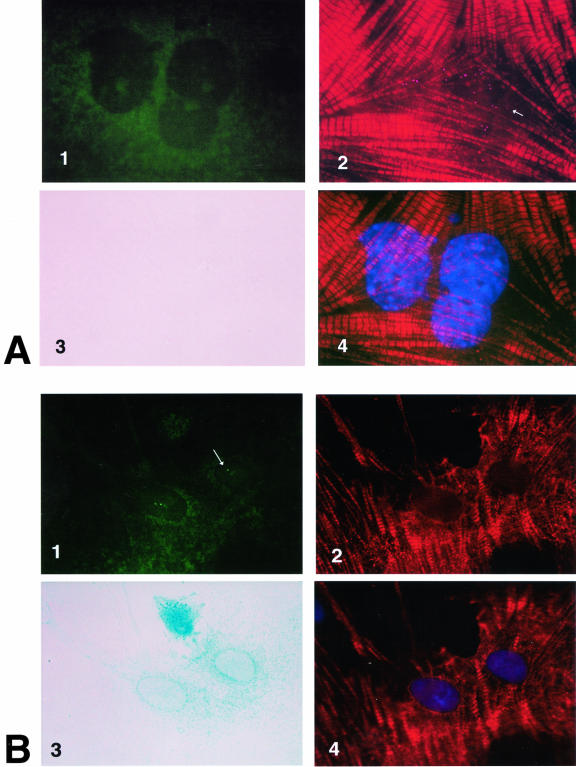Figure 4.
Double FISH on mouse neonatal cell/WB F344 cell co-cultures. The FISH was conducted after performing the β-gal reaction and the immunochemistry to demonstrate β-galactosidase and cardiac-specific protein expression in WB F344-derived cardiomyocytes. The mouse line 1 DNA and the rat-specific DNA probes were used simultaneously in the same probe mix on the same mouse/rat co-culture. A: The mouse L1 DNA probe hybridized with a mouse myocyte nuclear DNA. Punctate rhodamine-positive speckles in the nuclei in A2 (arrow) represent clusters of mouse L1 DNA. Some are artificially enhanced to differentiate their signal from the Texas Red striations in the sarcomeres. The nuclei of the same cell are shown with the 4,6-diamidino-2-phenylindole stain in A4. This mouse-derived myocyte does not express β-galactosidase (A3), nor does it hybridize with the rat DNA probe (A1). B: The rat-specific DNA probe hybridizes with the rat WB F344-derived myocyte nuclei. The two green fluorescent (fluorescein isothiocyanate-positive) dots in the nuclei of a WB F344-derived myocyte (B1, arrow) reflect high-affinity hybridization sites of the rat DNA probe with the Y-chromosome of the male WB F344-derived myocyte and with less affinity with alleles on chromosome 3 and/or 12.23 This WB F344-derived myocyte does not hybridize with mouse L1 DNA (B2). The nuclei of this WB F344-derived myocyte are shown with the 4,6-diamidino-2-phenylindole stain in B4. Unlike the mouse-derived myocyte, this WB F344-derived myocyte expresses β-galactosidase. Both the mouse neonatal myocyte and the WB F344-derived myocyte express cTnT (striations), probed with mAb 13-11. mAb 13-11 recognizes a cTnT epitope conserved across species and does not recognize skeletal muscle TnT. A Texas Red-labeled anti-mouse antibody was used as a secondary antibody. Using a long-pass filter, the Texas Red emission bled through the rhodamine range, and sarcomeric cTnT striations are evident in the myocytes (A2 and A4, B2 and B4). Only the WB F344-derived myocyte (B3) expresses β-galactosidase. Original magnifications, ×100.

